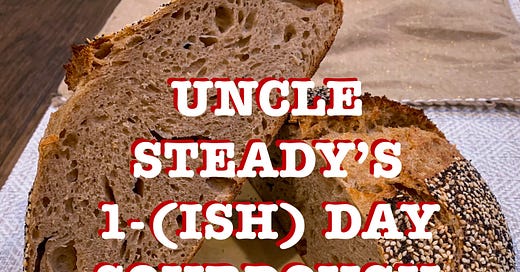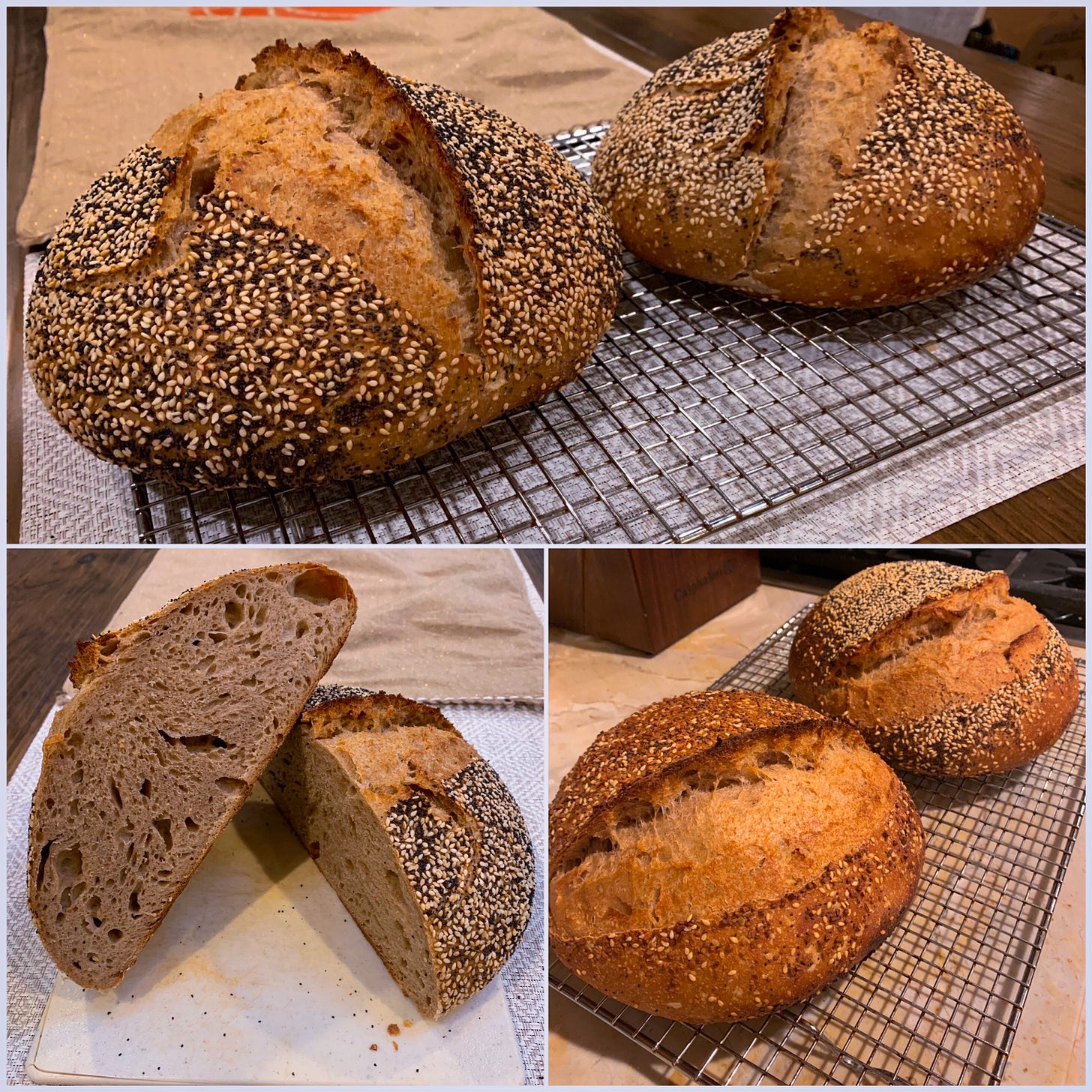Uncle Steady’s 1-(ish) Day Sourdough Bread
A guest post for those of you who haven’t been sourdough pilled yet!
CWD Note: This week’s post comes courtesy of Uncle Steady, a loyal CWD reader and all around wonderful guy. He was so kind as to gift Mrs. CWD and I some sourdough starter almost a year ago, which led us down the rabbit-hole of bread making. We still keep a printed copy1 of his recipe (which you’ll find below) in our recipe book and break it out every two weeks or so when we bake a new batch of bread. I don’t think we’ve bought bread from the store since.
Of course, this recipe is far more involved than our typical CWD fare — it’s going to take some commitment. If you don’t have the time, patience, or perceived skill2 to undertake this endeavor on your own, I’m sure Steady’s feeling won’t be hurt. But I would encourage you to give it a go — not only does homemade bread taste much better than anything from the store, I think it’s an important exercise to do in order to understand where your food comes from, how it’s made, and what it entails. I could3 go on a long tirade about the modern disconnect from our food, but that’s a topic for another newsletter. For now, sit back and enjoy Uncle Steady’s all-encompassing instruction!
Sup nerds! (Am I doing this right?)4
In another life5, Mrs Steady and I lived out west in the San Francisco Bay Area. After an early morning of dodging landlords6 in search for the green room7 at Ocean Beach SF, we would regularly visit our favorite brunch spot - Tartine Bakery. I was never a big fan of sourdough bread, but that all changed the first time I had sourdough from Tartine. The deep, complex flavor with the perfect balance of "tangy" vs "yogurt-y" flavor was unlike anything I'd ever tasted before. It's truly a completely different taste than a grocery store bought sourdough loaf - even in the Bay Area! From that point forward, I knew I had to learn how to make bread like this.
Following this revelation, I quickly bought the book, Tartine Bread, that describes the bakery's process in detail. My initial enthusiasm turned to frustration as I learned how inconsistent sourdough bread baking can be. I even transported starter to Gma and Papa's house in PA for Thanksgiving one year, only to produce a sad, dense, flavorless, pancake-loaf8. The family exclaimed something like: "Oh wow, you can really taste the flavor!”
They were very gracious, but deep down I knew what sourdough could be and how far I was from it. After about another year of experimentation, I was finally able to consistently produce a loaf that I was proud of.
Luckily for you, dear reader, I will now attempt to distill these learnings below.
The general recipe was adapted from the Tartine bread recipe which can be found in the book, or here on here Tartine website.
The Starter:
Sourdough starter creation and maintenance is the single most important part of sourdough bread making. It is the base for what flavor you're able to produce in the loaf.
In theory, it's very simple: mix water and flour in a 1:1 ratio by weight (100g9 of each is what I'd recommend), then wait. After a day or so, discard all but 50g and repeat.
In practice, it's very fickle and takes a lot of patience to develop a good tasting, mature starter. It is also very dependent on temperature and time.
I've found that a mature starter takes ~6 months to develop. When Mrs Steady and I moved to MA, I dried my long-time CA starter and re-hydrated it in MA. Even then, it took a few months to adapt to the new environment and finally produce good loaves.
Overall, my recommendation is to find someone who already has a mature starter and use that. It will save you a lot of time and frustration10.
Keep in mind that the frequency and temperature of starter maintenance does make a difference to flavor and potency of your starter.
The longer your starter is left in the fridge, the more the yeast will die, but it can help develop "tangy" flavors due to the acetic acid produced by the bacteria in cold temperatures.
Developing Flavor:
Before I get to the recipe, I want to discuss sourdough flavor in more detail.
Sourdough flavor is very dependent on temperature, so we must change the temperature of the loaves to develop the flavor we wish to have.
Below is a general guide to the flavors that different temperatures produce:
82°-85° gives higher base sourness (lactic acid aka yogurt-y flavor)
70°-75° gives mild flavors (Ideally, limit time in this range)
35°- 52° gives more tangy flavor (acetic acid)
You can focus on any of these flavors in particular, but if you're looking for the "complexity" of SF-style sourdough bread, you need to vary the temperature throughout the proofing process.
Traditionally, in SF, bakers can start the loaves mid-day in warm weather, then allow for a cold-proof overnight as the cold temperatures return with the fog11. Then bread is baked first thing the next morning. I've found that it's important to start with warm temperatures (at least through the bulk rise - more on this below) to ensure the yeast are active enough to properly rise the dough. During the second rise, we can retard the dough in the fridge and bake directly from there.
This time intensive and quirky process is why most bakeries don't go through the effort to produce "true" sourdough bread.
Most store-bought sourdough12 use a starter for flavor, but rely on dry-yeast to provide a consistent rise in a shorter timeframe. Once you get used to good sourdough, the difference is obvious.
Recipe:
Finally, the moment we've been waiting for. Below is the recipe and typical schedule I follow.
I call it "1-ish Day" since some prep is required the night before baking.
Ingredients
Bread Flour
Whole Wheat Flour
Salt
(opt) Sesame seeds or other topping
Starter Maintenance
100g Flour (50g white, 50g wheat)
100g Water (i.e. 100% hydration in "bakers percentages13")
20g Starter (i.e. 20% starter, increase to 30% if old/sluggish starter)
Mix above together in mason jar (loose lid) and store in 80-85deg until rise and begin to fall, then move into fridge
Feed starter every 2-3 weeks if not baking bread
1-ish Day Sourdough Bread Recipe
Night before (~8pm)
Create Levain: Feed starter with 2x starter recipe
Overnight Autolyse (8)
1000g Flour (50/50 or any other desired split14)
750g water (75% hydration)
Mix above together and cover bowl with a towel overnight
Bake Day
Morning (~7am): Bulk Fermentation
Add Salt (20g/2%) and Levain (200g/20%, increase to 30% if sluggish)
Mix everything and cover with towel in ~85deg
Feed starter using starter recipe15. Keep this starter next to the bread at all times. This will be used to gauge fermentation progress
@20%-50% rise in starter/gauge (~noon): Shaping and Bench Rest
Remove dough from bowl and cut in half
Shape each half into boule16, cover with towel, wait 30m
Re-shape boule, add sesame seeds (opt) and place upside down into proofing basket (or bowl with towel underneath)
Place baskets+starter back into 85(F) area
@75-100% rise in starter/gauge (~4pm): Retard
Place loaves in fridge for at least 2 hrs. This helps develop acetic acid ("tang") sour flavor and makes handling/scoring easier with inflated dough
If you wish to do an extended retard in the fridge, this is the time to do it. You can bake the next day or even later if you're feeling adventurous
Starter stays out of fridge until it begins to fall, then put in fridge for storage
Bake (After 2hrs in fridge, ~6-8pm)
Preheat oven and dutch oven to 500(F)
Place bread into shallow half of dutch oven, score top, cover with deep half and reduce heat to 450(F) for 20m
After 20m, remove top of dutch oven and bake for another 20m (40m total at 450deg)
Repeat above for next loaf
If all goes right, you should hopefully produce loaves like this:
Common issue troubleshooting
Pancake loaf (bread not rising during baking)
Possible Causes:
Sluggish starter/levain - is your levain doubling in size overnight? If not, you either need a more mature starter, or must use a higher % levain in the bread
Fermenting in too cold temperature or for not long enough - This is the purpose of having a starter alongside the bread. If your starter is not doubling in the same conditions, you can be sure that your bread is not rising enough either. Try using a warmer spot, or fermenting longer.
Mild taste
Possible Causes:
Young starter - If your starter has not matured sufficiently, it won't produce the complex flavors we're looking for.
Bulk rise in too cool of temperatures - If your house is in the mid-60s, the ambient temperature on the counter may be too cool to develop good base sourness. Your starter may adapt/mature to this temperature over time - or it might not.
False Crumb
False Crumb is large pockets of air that usually develop just under the top crust. Natural air pockets from yeast are great, but "false" crumb is caused by the boule shaping process. If you have false crumb developing, be sure not to introduce air pockets in the loaf shaping process.
Score on top of loaf not producing an "ear"
The most obvious case is the bread not rising enough. See above
If bread is rising properly, ensure the angle of the scoring blade is as shallow as possible. If slicing directly into the surface is 90deg, aim for an angle less than a 45 degrees.
So there you have it folks: sourdough bread! Simple as can be. If you have any questions, please direct them to Uncle Steady in the comments.
With that, I’ll leave you to your weekends. Could be a good one to get your sourdough started!
Now tattered, flour stained, and crumpled.
It’s not hard, just complex, really!
And probably will, one day.
CWD Note: Yep, exactly right!
Read: Pre-pandemic and/or pre-children
AKA Men in Grey Suits, AKA White Sharks - In reality I only saw them a few times. More commonly, it was dolphins and seals
AKA shacks, kegs, curtain calls, pits, or simply "barrels"
I LOVE pancakes, but not with my sourdough
CWD Note: If you really want to start making your own bread, you’re going to need to buy a kitchen scale (if you don’t already have one)
CWD Note: As I’ve alluded to before, we were gifted our starter from Uncle Steady. We tried starting our own (pun!) back in “another life,” but couldn’t for the life of us get it to mature properly.
This is the case with many "good' bakeries as well that don't specialize in making sourdough bread.
"Bakers percentages" are just % weight based on the amount of flour in the recipe - not based on total weight of recipe.
CWD Note: We’ve lately been doing 75% bread flour / 25% white whole wheat flour.
CWD Note: This means make a new “starter recipe” in a new mason jar, not just adding new flour and water to your old one!
CWD Note: This is baker speak for a round loaf







Is Uncle Steady a scientist?